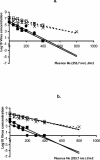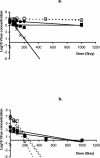Calicivirus inactivation by nonionizing (253.7-nanometer-wavelength [UV]) and ionizing (gamma) radiation
- PMID: 15345386
- PMCID: PMC520909
- DOI: 10.1128/AEM.70.9.5089-5093.2004
Calicivirus inactivation by nonionizing (253.7-nanometer-wavelength [UV]) and ionizing (gamma) radiation
Abstract
Noroviruses (previously Norwalk-like viruses) are the most common viral agents associated with food- and waterborne outbreaks of gastroenteritis. In the absence of culture methods for noroviruses, animal caliciviruses were used as model viruses to study inactivation by nonionizing (253.7-nm-wavelength [UV]) and ionizing (gamma) radiation. Here, we studied the respiratory feline calicivirus (FeCV) and the presumed enteric canine calicivirus (CaCV) and compared them with the well-studied bacteriophage MS2. When UV irradiation was used, a 3-log(10) reduction was observed at a fluence of 120 J/m(2) in the FeCV suspension and at a fluence of 200 J/m(2) for CaCV; for the more resistant phage MS2 there was a 3-log(10) reduction at a fluence of 650 J/m(2). Few or no differences were observed between levels of UV inactivation in high- and low-protein-content virus stocks. In contrast, ionizing radiation could readily inactivate MS2 in water, and there was a 3-log(10) reduction at a dose of 100 Gy, although this did not occur when the phage was diluted in high-protein-content stocks of CaCV or FeCV. The low-protein-content stocks showed 3-log(10) reductions at a dose of 500 Gy for FeCV and at a dose of 300 for CaCV. The inactivation rates for both caliciviruses with ionizing and nonionizing radiation were comparable but different from the inactivation rates for MS2. Although most FeCV and CaCV characteristics, such as overall particle and genome size and structure, are similar, the capsid sequences differ significantly, making it difficult to predict human norovirus inactivation. Adequate management of UV and gamma radiation processes for virus inactivation should limit public health risks.
Figures



References
-
- Baron, R. C., F. D. Murphy, H. B. Greenberg, C. E. Davis, D. J. Bregman, G. W. Gary, J. M. Hughes, and L. B. Schonberger. 1982. Norwalk gastrointestinal illness: an outbreak associated with swimming in a recreational lake and secondary person-to-person transmission. Am. J. Epidemiol. 115:163-172. - PubMed
-
- Beller, M., A. Ellis, S. H. Lee, M. A. Drebot, S. A. Jenkerson, E. Funk, M. D. Sobsey, O. D. Simmons III, S. S. Monroe, T. Ando, J. Noel, M. Petric, J. P. Middaugh, and J. S. Spika. 1997. Outbreak of viral gastro-enteritis due to a contaminated well. JAMA 278:563-568. - PubMed
Publication types
MeSH terms
LinkOut - more resources
Full Text Sources

